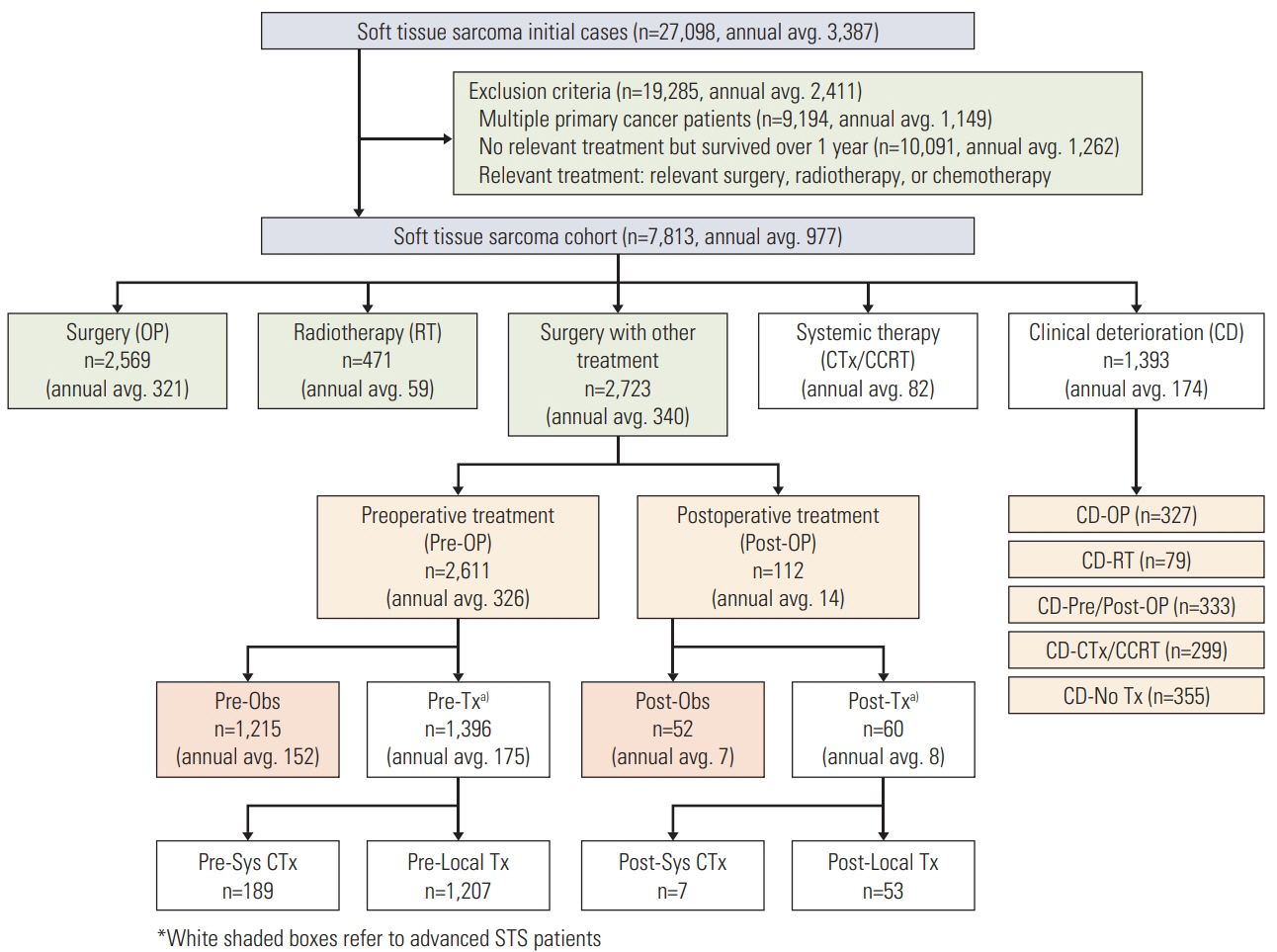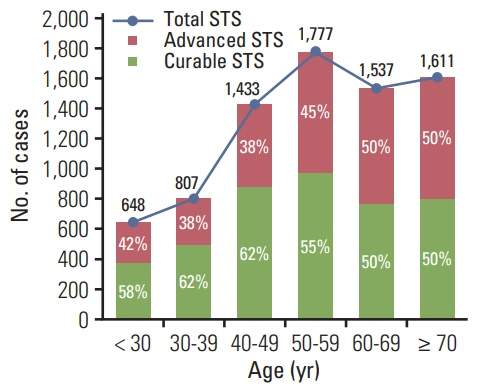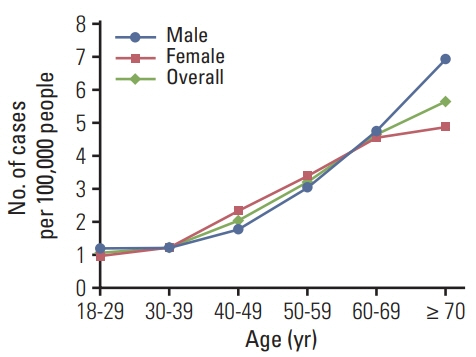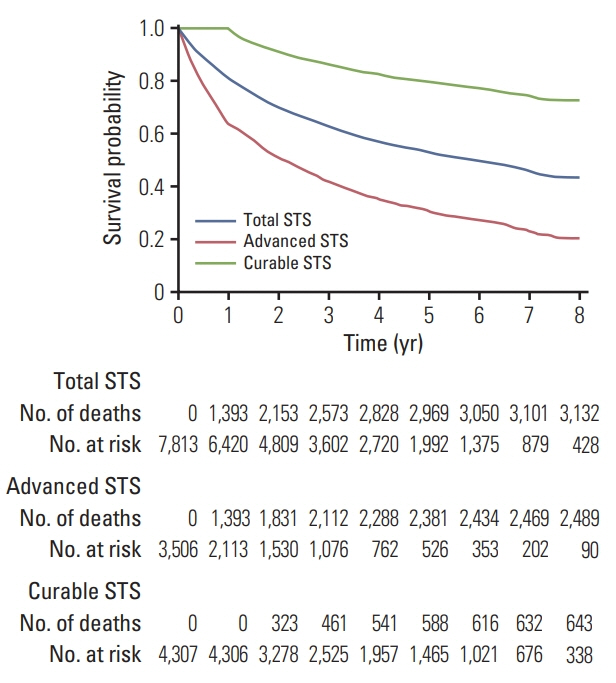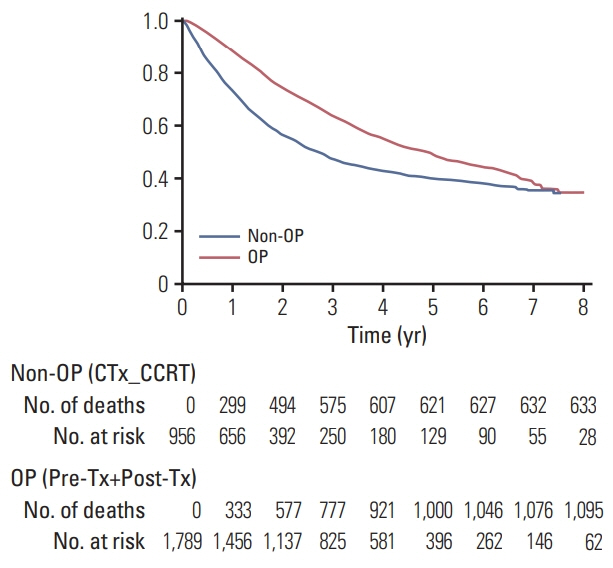Cancer Res Treat.
2019 Oct;51(4):1380-1391. 10.4143/crt.2018.476.
Characteristics and Treatment Patterns of Patients with Advanced Soft Tissue Sarcoma in Korea
- Affiliations
-
- 1Division of Medical Oncology, Department of Internal Medicine, Yonsei Cancer Center, Yonsei University College of Medicine, Seoul, Korea. rha7655@yuhs.ac
- 2Department of Preventive Medicine, Yonsei University College of Medicine, Seoul, Korea.
- 3Department of Preventive Medicine, Eulji University College of Medicine, Daejeon, Korea.
- 4Department of Biomedical Systems Informatics, Yonsei University College of Medicine, Seoul, Korea.
- 5Department of Public Health, Yonsei University Graduate School, Seoul, Korea.
- 6Parc Sanitari Sant Joan de Déu, Fundació Sant Joan de Déu, CIBERSAM, Universitat de Barcelona, Barcelona, Spain.
- 7Eli Lilly and Company, Seoul, Korea.
- 8Eli Lilly and Company, Windlesham, UK. novick_diego@lilly.com
- KMID: 2460587
- DOI: http://doi.org/10.4143/crt.2018.476
Abstract
- PURPOSE
A soft tissue sarcoma (STS) is a rare type of cancer, accounting for 1% of adult solid cancers. The aim of the present study is to determine the incidence of localized and advanced STS in Korean patients, their treatment patterns, and the survival of patients by disease status.
MATERIALS AND METHODS
The STS patient cohort was defined using National Health Insurance Service medical data from 2002 to 2015. Incidence, distribution, anatomical location of tumors, survival rates (Kaplan-Meyer survival function) and treatment patterns were analyzed by applying different algorithms to the STS cohort containing localized and advanced STS cases.
RESULTS
A total of 7,813 patients were diagnosed with STS from 2007 to 2014, 4,307 were localized STS and 3,506 advanced STS cases. The total incidence of STS was 2.49 per 100,000 person- years: 1.37 per 100,000 person-years for localized STS and 1.12 per 100,000 person-years for advanced STS. The 5-year survival rate after diagnosis was 56.4% for all STS, 82.4% for localized, and 27.2% for advanced STS. Half of the advanced STS patients (49.98%) received anthracycline-containing chemotherapy as initial treatment after diagnosis.
CONCLUSION
This study provides insights into localized and advanced STS epidemiology, treatment patterns and outcomes in Korea, which could be used as fundamental data in improving clinical outcomes of STS patients in the future.
MeSH Terms
Figure
Reference
-
References
1. Wibmer C, Leithner A, Zielonke N, Sperl M, Windhager R. Increasing incidence rates of soft tissue sarcomas? A population-based epidemiologic study and literature review. Ann Oncol. 2010; 21:1106–11.
Article2. Burningham Z, Hashibe M, Spector L, Schiffman JD. The epidemiology of sarcoma. Clin Sarcoma Res. 2012; 2:14.
Article3. Casali PG, Blay JY; ESMO/CONTICANET/EUROBONET Consensus Panel of experts. Soft tissue sarcomas: ESMO Clinical Practice Guidelines for diagnosis, treatment and followup. Ann Oncol. 2010; 21 Suppl 5:v198–203.
Article4. Schoffski P, Cornillie J, Wozniak A, Li H, Hompes D. Soft tissue sarcoma: an update on systemic treatment options for patients with advanced disease. Oncol Res Treat. 2014; 37:355–62.
Article5. Siegel RL, Miller KD, Jemal A. Cancer statistics, 2016. CA Cancer J Clin. 2016; 66:7–30.
Article6. Stiller CA, Trama A, Serraino D, Rossi S, Navarro C, Chirlaque MD, et al. Descriptive epidemiology of sarcomas in Europe: report from the RARECARE project. Eur J Cancer. 2013; 49:684–95.
Article7. Statistics Korea. Estimates of future population 2010-2060 [Internet]. Daejeon: Statistics Korea;2011. [cited 2018 Dec 10]. Available from: http://kosis.kr./eng/.8. Kang S, Kim HS, Choi ES, Han I. Incidence and treatment pattern of extremity soft tissue sarcoma in Korea, 2009-2011: a nationwide study based on the Health Insurance Review and Assessment Service database. Cancer Res Treat. 2015; 47:575–82.
Article9. Fletcher CD, Unni KK, Mertens F. World Health Organization classification of tumours pathology and genetics of tumours of soft tissue and bone. Lyon: IARC Press;2002.10. Corless CL, Schroeder A, Griffith D, Town A, McGreevey L, Harrell P, et al. PDGFRA mutations in gastrointestinal stromal tumors: frequency, spectrum and in vitro sensitivity to imatinib. J Clin Oncol. 2005; 23:5357–64.
Article11. Italiano A, Mathoulin-Pelissier S, Cesne AL, Terrier P, Bonvalot S, Collin F, et al. Trends in survival for patients with metastatic soft-tissue sarcoma. Cancer. 2011; 117:1049–54.
Article12. Sheng JY, Movva S. Systemic therapy for advanced soft tissue sarcoma. Surg Clin North Am. 2016; 96:1141–56.
Article13. Krikelis D, Judson I. Role of chemotherapy in the management of soft tissue sarcomas. Expert Rev Anticancer Ther. 2010; 10:249–60.
Article14. Seong SC, Kim YY, Khang YH, Heon Park J, Kang HJ, Lee H, et al. Data resource profile: the National Health Information Database of the National Health Insurance Service in South Korea. Int J Epidemiol. 2017; 46:799–800.15. Ogura K, Higashi T, Kawai A. Statistics of soft-tissue sarcoma in Japan: report from the Bone and Soft Tissue Tumor Registry in Japan. J Orthop Sci. 2017; 22:755–64.
Article16. SEER cancer statistics review, 1975-2008 [Internet]. Bethesda, MD: National Cancer Institute;2011. [cited 2018 Dec 10]. Available from: http://seer.cancer.gov/csr/1975_20.17. Ray-Coquard I, Collard O, Ducimetiere F, Laramas M, Mercier F, Ladarre N, et al. Treatment patterns and survival in an exhaustive French cohort of pazopanib-eligible patients with metastatic soft tissue sarcoma (STS). BMC Cancer. 2017; 17:111.
Article18. Maretty-Nielsen K, Aggerholm-Pedersen N, Safwat A, Baerentzen S, Pedersen AB, Keller J. Prevalence and prognostic impact of comorbidity in soft tissue sarcoma: a population-based cohort study. Acta Oncol. 2014; 53:1188–96.
Article19. Toro JR, Travis LB, Wu HJ, Zhu K, Fletcher CD, Devesa SS. Incidence patterns of soft tissue sarcomas, regardless of primary site, in the surveillance, epidemiology and end results program, 1978-2001: an analysis of 26,758 cases. Int J Cancer. 2006; 119:2922–30.
Article20. Bhatt N, Deady S, Gillis A, Bertuzzi A, Fabre A, Heffernan E, et al. Epidemiological study of soft-tissue sarcomas in Ireland. Cancer Med. 2016; 5:129–35.
Article21. Francis M, Dennis N, Charman J, Lawrence G, Grimer R. Bone and soft tissue sarcomas: UK incidence and survival: 1996 to 2010. London: National Cancer Intelligence Network;2013.22. Gustafson P. Soft tissue sarcoma. Epidemiology and prognosis in 508 patients. Acta Orthop Scand Suppl. 1994; 259:1–31.23. Yang L, Fang ZW, Fan ZF, Wang N, Yuan YN, Li HC, et al. An analysis of incidence trends and characteristics of soft tissue sarcoma in Beijing, 1999-2013. Zhonghua Zhong Liu Za Zhi. 2017; 39:471–6.24. Forman D, Bray F, Brewster DH, Gombe Mbalawa C, Kohler B, Pineros M, et al. Cancer incidence in five continents. Vol. X. Lyon: International Agency for Research on Cancer;2014.25. Surveillance, Epidemiology, and End Results Program [Internet]. Bethesda, MD: National Cancer Institute;2016. [cited 2018 Dec 20]. Available from: http://www.seer.cancer.gov.26. Mytelka DS, Lorenzo M, Stafkey-Mailey D, D'Yachkova Y, Nagar SP, Candrilli SD, et al. Advanced soft tissue sarcoma: systemic treatment patterns and survival in Germany. Value Health. 2016; 19:A76.
Article27. Mytelka DS, Lorenzo M, Stafkey-Mailey D, D'Yachkova Y, Nagar SP, Candrilli SD, et al. Real-world treatment patterns and outcomes for patients with advanced soft tissue sarcoma receiving systemic therapy in the United Kingdom. Value Health. 2016; 19:A751.
Article28. Bae S, Crowe P, Gowda R, Joubert W, Carey-Smith R, Stalley P, et al. Patterns of care for patients with advanced soft tissue sarcoma: experience from Australian sarcoma services. Clin Sarcoma Res. 2016; 6:11.
Article29. Judson I, Verweij J, Gelderblom H, Hartmann JT, Schoffski P, Blay JY, et al. Doxorubicin alone versus intensified doxorubicin plus ifosfamide for first-line treatment of advanced or metastatic soft-tissue sarcoma: a randomised controlled phase 3 trial. Lancet Oncol. 2014; 15:415–23.
Article30. Tap WD, Jones RL, Van Tine BA, Chmielowski B, Elias AD, Adkins D, et al. Olaratumab and doxorubicin versus doxorubicin alone for treatment of soft-tissue sarcoma: an open-label phase 1b and randomised phase 2 trial. Lancet. 2016; 388:488–97.
Article31. Hoang HL, Ensor K, Rosen G, Leon Pachter H, Raccuia JS. Prognostic factors and survival in patients treated surgically for recurrent metastatic uterine leiomyosarcoma. Int J Surg Oncol. 2014; 2014:919323.
Article32. Potter DA, Glenn J, Kinsella T, Glatstein E, Lack EE, Restrepo C, et al. Patterns of recurrence in patients with high-grade softtissue sarcomas. J Clin Oncol. 1985; 3:353–66.
Article
- Full Text Links
- Actions
-
Cited
- CITED
-
- Close
- Share
- Similar articles
-
- Alveolar soft part Sarcoma with Metastasis to Bone: A Case Report
- Update on the Management of Extremity Soft Tissue Sarcoma
- Infantile Extraosseous Ewing's Sarcoma in the Left Arm: A Case Report
- Sonographic Features of Common Soft Tissue Masses in the Extremities
- A Clinical Study of Soft Tissue Sarcoma in Orthopedic Surgery

